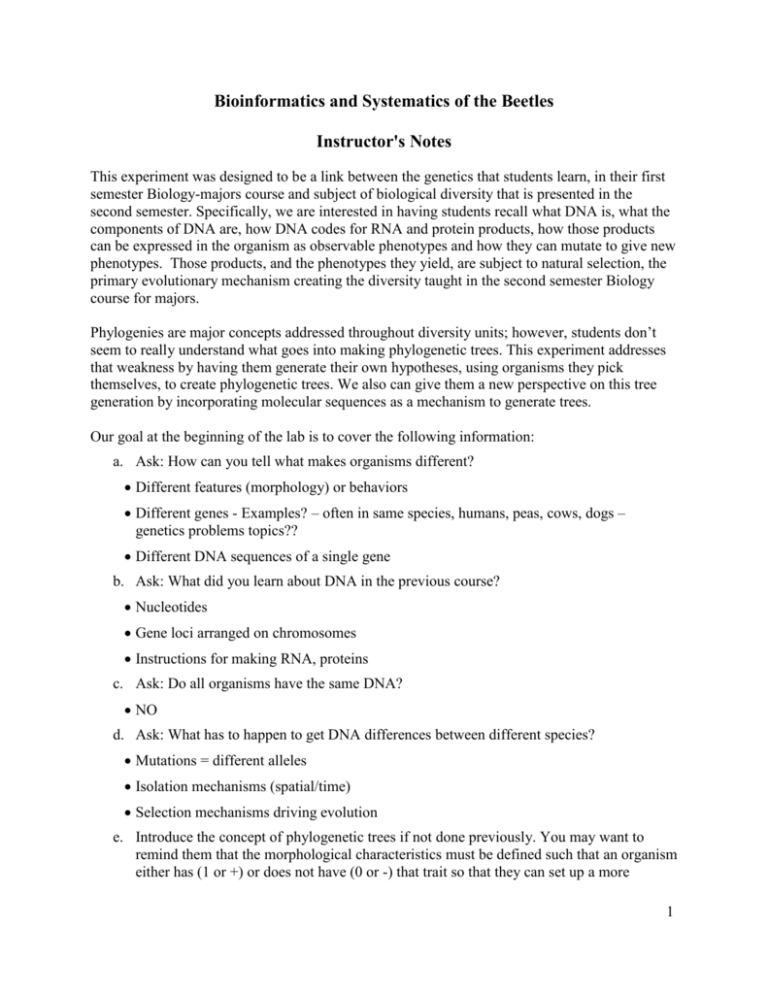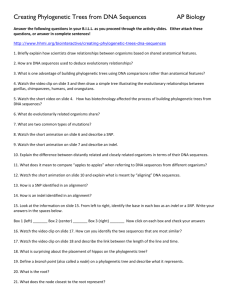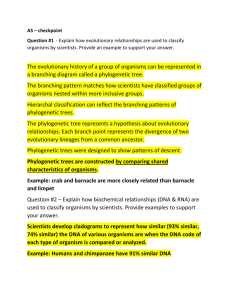doc - Bean Beetles
advertisement

Bioinformatics and Systematics of the Beetles Instructor's Notes This experiment was designed to be a link between the genetics that students learn, in their first semester Biology-majors course and subject of biological diversity that is presented in the second semester. Specifically, we are interested in having students recall what DNA is, what the components of DNA are, how DNA codes for RNA and protein products, how those products can be expressed in the organism as observable phenotypes and how they can mutate to give new phenotypes. Those products, and the phenotypes they yield, are subject to natural selection, the primary evolutionary mechanism creating the diversity taught in the second semester Biology course for majors. Phylogenies are major concepts addressed throughout diversity units; however, students don’t seem to really understand what goes into making phylogenetic trees. This experiment addresses that weakness by having them generate their own hypotheses, using organisms they pick themselves, to create phylogenetic trees. We also can give them a new perspective on this tree generation by incorporating molecular sequences as a mechanism to generate trees. Our goal at the beginning of the lab is to cover the following information: a. Ask: How can you tell what makes organisms different? Different features (morphology) or behaviors Different genes - Examples? – often in same species, humans, peas, cows, dogs – genetics problems topics?? Different DNA sequences of a single gene b. Ask: What did you learn about DNA in the previous course? Nucleotides Gene loci arranged on chromosomes Instructions for making RNA, proteins c. Ask: Do all organisms have the same DNA? NO d. Ask: What has to happen to get DNA differences between different species? Mutations = different alleles Isolation mechanisms (spatial/time) Selection mechanisms driving evolution e. Introduce the concept of phylogenetic trees if not done previously. You may want to remind them that the morphological characteristics must be defined such that an organism either has (1 or +) or does not have (0 or -) that trait so that they can set up a more 1 simplistic table of data to work from. Explain that the more homologous features organisms have in common, the more recent the common ancestor. f. Introduce the concept of data processing by computer. How did scientists analyze these data by hand? You may want to hand out a DNA nucleotide or amino acid sequence of two different organisms and ask them to analyze it. Ask them if there is an easier method today…..Computers! Explain that the bean beetle genome is now available and what work will be done with those sequences in the future using the tools we will be introducing. Once the students get started, they will need much guidance to select characters. Many will want to choose color or pattern differences. We try to steer them away from these traits because they are often highly variable within species and often vary in a gradual manner between species. Remind them that organisms will have some physical differences that may not hold true for all specimens within one species. This can be readdressed if they see differences between the generated trees at the end. The best traits for phylogenetic trees are categorical, either a characteristic is present or it is absent, or a trait has very easily recognized forms. Once they understand how characters should be selected, students generally proceed successfully through the rest of the procedures. Experimental Design This project shows students a different way to generate and test hypotheses compared to the experiments they have performed previously. A list of questions that students are likely to address includes: 1. What do phylogenies tell us? 2. What characters can be used to generate phylogenetic trees? 3. Why would phylogenetic trees generated with different types of data differ? 4. How are phylogenetic trees generated with different types of data reconciled? The control of a phylogenetic analysis is an outgroup. For an introductory course we recommend students select an outgroup belonging to a different insect order. Bean beetles, Callosobruchus maculatus, could be used as an outgroup, with the remaining species in the analysis all belonging to a different beetle family, in an upper-level systematics or entomology course. Data Collection We conducted this experiment using bean beetles as the outgroup. We decided that comparing four other beetle species to the bean beetles would provide an appropriate level of difficulty in developing phylogenetic trees. Students should collect data on at least four morphological differences for these five species. Morphological data can be acquired through online images of the beetles (see Student Handout for sources), or through preserved specimens if collections are accessible. We caution that online images generally present limited views of the insects. Several images from several angles, especially dorsal and ventral, are recommended. We also recommend students paste all images into a single page to observe them together. 2 Preserved specimens provide more useful morphological data. Ecology can be incorporated into this activity by having students collect their own beetles, and note which species are abundant in various habitats. In this case, students identify their beetles before browsing NCBI for protein sequences of those species. Beetle species were selected using scientific or common names, and the species must share at least one protein sequence available on GENBANK. We recommend mitochondrial sequences such as cytochrome oxidase subunit I (COI) (Lunt et al., 1996), cytochrome b (Castresana, 2001), NADH dehydrogenase (Zardoya and Meyer, 1996), and 12S rRNA (Kambhampati, 1996) (only nucleotide sequences available for latter) because there is a high degree of interspecific variation due to rapid mutation rate of mitochondrial genes. We have only used COI in our courses to date. Data Analysis Statistical analyses of phylogenies were not performed. We used the website http://www.phylogeny.fr/ (Dereeper et al., 2008) to generate phylogenies from FASTA sequences. Equipment and supplies Computers with printer connected to the internet. One per student would be ideal, but students could work in small groups. Preserved beetles or collecting supplies. Beetle or insect field guides and other books for identifying collected specimens. Literature Cited Castresana, J. 2001. Cytochrome b Phylogeny and the Taxonomy of Great Apes and Mammals. Molecular Biology and Evolution 18 (4):465–471. Dereeper, A., Guignon, V., Blanc, G., Audic, S., Buffet, S., Chevenet, F., Dufayard, J.F., Guindon, S., Lefort, V., Lescot, M., Claverie, J.M. and Gascuel, O. 2008. Phylogeny.fr: robust phylogenetic analysis for the non-specialist. Nucleic Acids Research Jul 1; 36 (Web Server Issue):W465-9. Epub 2008 Apr 19. Kambhampati, S. 1996. Phylogenetic relationship among cockroach families inferred from mitochondrial12S rRNA gene sequence. Systematic Entomology 21:89–98. Lunt, D.H., Zhang, D.X, Szymura, J.M and Hewitt G.M. 1996. The insect cytochrome oxidase I gene: evolutionary patterns and conserved primers for phylogenetic studies. Insect Molecular Biology 5(3):153-65. Zardoya, R. and Meyer, A. 1996. Phylogenetic performance of mitochondrial protein-coding genes in resolving relationships among vertebrates. Molecular Biology and Evolution 13(7):933942. This experiment was written by Evan Lampert and Jennifer L. Mook, 2014 (www.beanbeetles.org). 3







